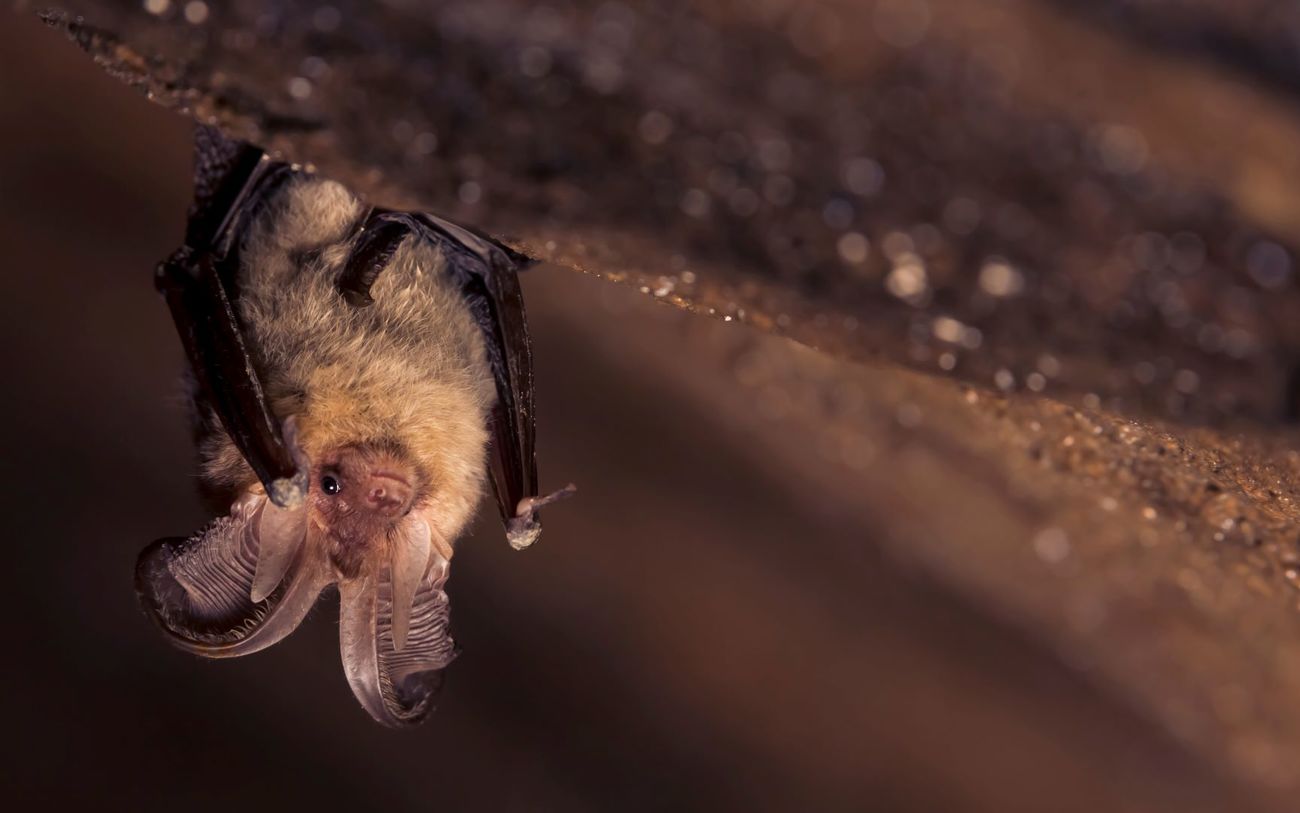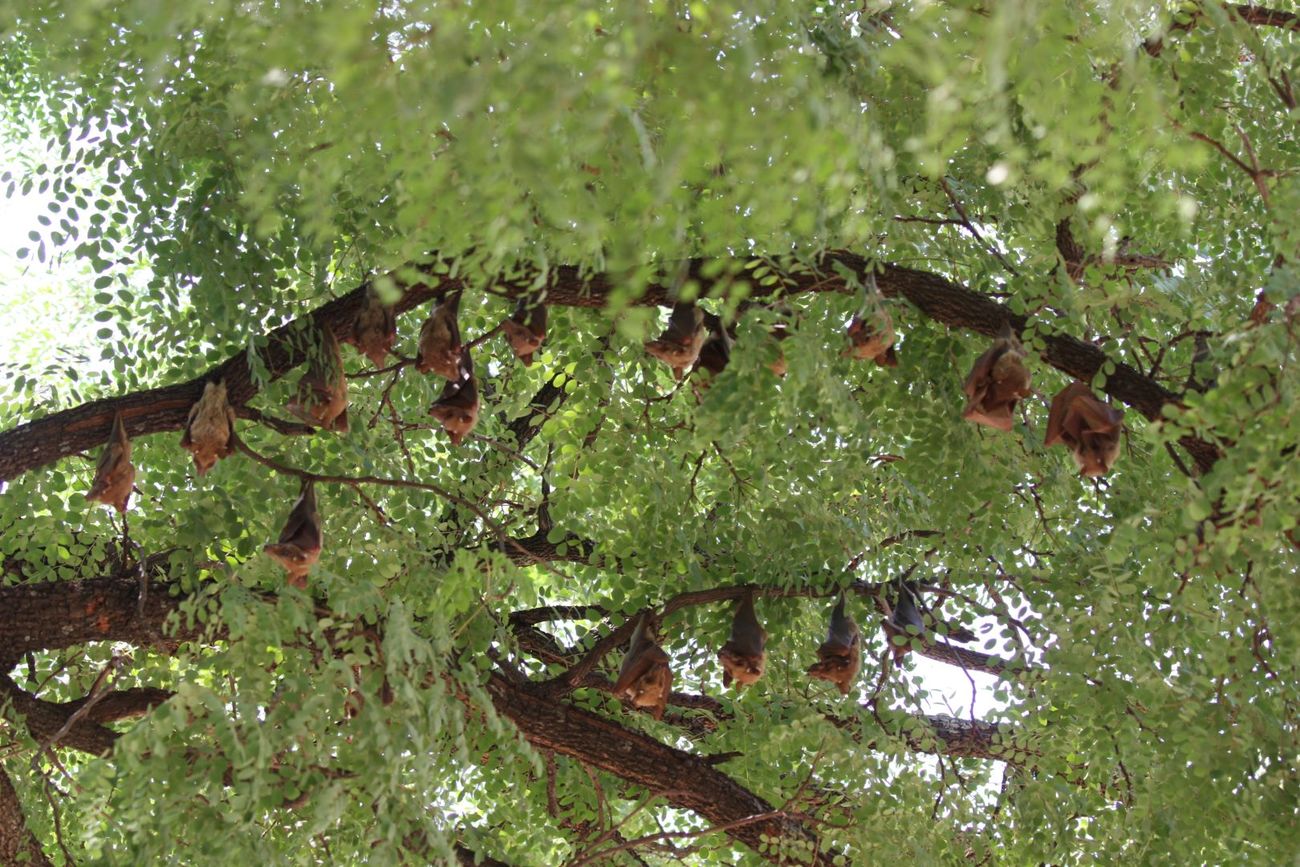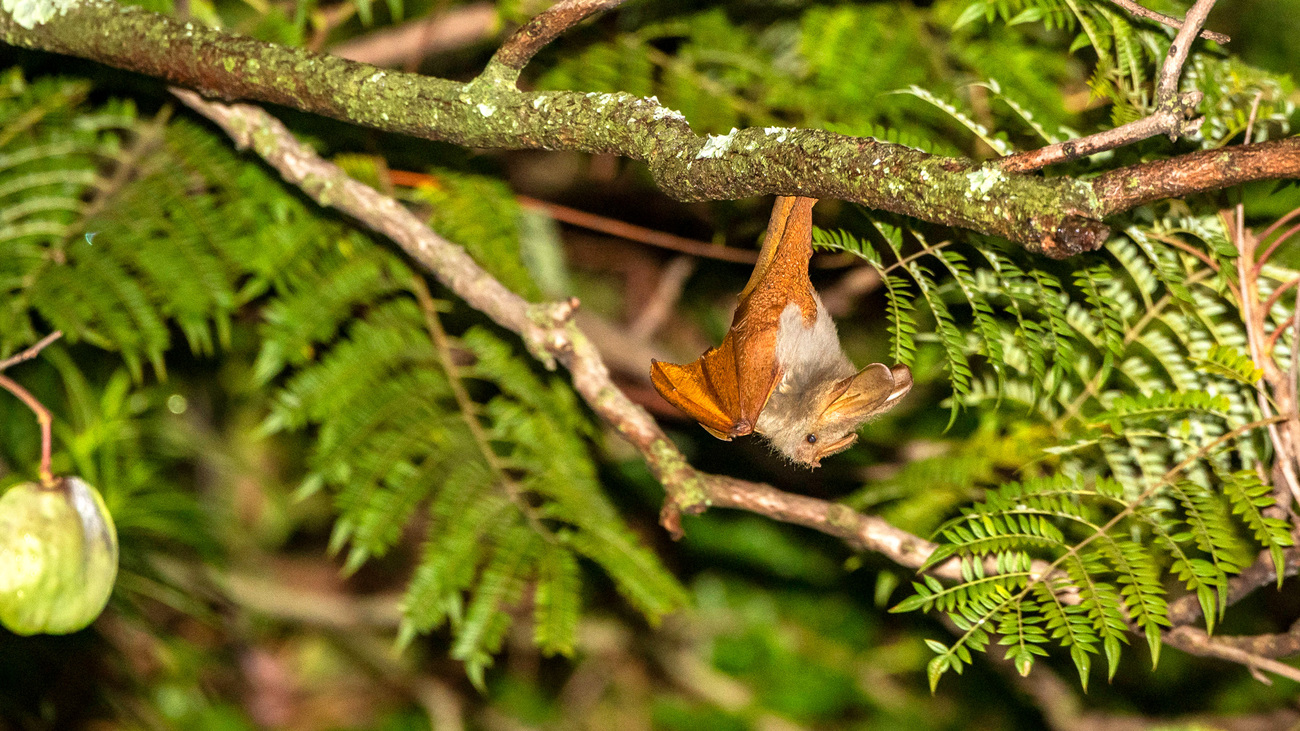Bats
Bats are one of the largest groups of mammals on the planet, with around 1,300 recognised species in the order Chiroptera. They come in various shapes and sizes, from the tiny bumblebee bat that weighs less than two grams to the flying fox, which has a wingspan of up to 1.5 metres. Aside from polar regions and extreme deserts, bats can be found almost anywhere on Earth, as they live off a wide range of diets, from the blood of large animals to flying insects, fruit, and even fish.
Though there are many bat species—and some have very large populations—these mammals have some of the slowest reproduction rates in the animal kingdom. Females typically give birth to just one pup per year—but when 100 million females gather to give birth, that still results in a very large number of baby bats.
Bats and bat pups are indicators of a healthy ecosystem and help to maintain its balance. Insect-eating bats control insect populations, while fruit-eating bats disperse seeds and pollinate flowers.
What is a bat’s scientific name?
The scientific name for bats is Chiroptera, which means ‘hand wing’ in Greek. This name refers to a bat’s long fingers, which are connected by a thin membrane to form their wings.
Though there are over 1,300 species of bats, they all fit into two main types: microbats and megabats. The former can live nearly anywhere and mostly feed on insects or blood, while the latter live in the tropics and survive on a diet of fruit, nectar, and pollen.
Are bats endangered?
There are many species of bat, each with their own conservation status. While some bat species are classed as ‘least concern’, others are critically endangered or have already gone extinct.
Critically endangered bat species include the Seychelles sheath-tailed bat, which has a population of fewer than 100 mature individuals; Livingstone’s flying fox, which has around 1,300 mature individuals; the New Caledonia long-eared bat, which has between 150 and 250 mature individuals; and the Thongaree’s disc-nosed bat, of which accurate population numbers are unknown, though the population is reportedly decreasing.
The Bonin Pipistrelle, which was last seen in 1889; the Guam flying fox, which was last observed in the 1960s; and the Lord Howe long-eared bat, which was last seen in 1972, are all classed as extinct.
Where do bats live?
Bats are found worldwide, except in polar regions and extreme deserts. They live in forests and wetlands as well as urban areas. During the day, they rest in shelters known as roosts, which include caves, mines, old buildings, and hollowed trees. To stay protected and out of sight, bats usually rest in small cracks and crevices, making it difficult for researchers to find them and learn about their roosting spots. They also rest upside down so they can drop quickly and fly away if needed. Bats that live in temperate climates tend to migrate in the winter to a cool roost where they can hibernate—some caves end up providing space for millions of bats to hibernate together.
There are over 100 species of bats in Africa and around 45 in the US. The UK only has insect-eating bat species. In total, there are around 829 known species that live in forests, 496 that live in caves, 247 that live in urban areas, and 188 that live in savannahs.
Threats
Bats face a number of threats, many of which are due to human activity. Climate change, habitat loss, hunting, and wind energy all increase bat mortality and are perpetuated by humans. Bats also struggle to recover from population decreases because of their slow reproduction rates and the effects of white-nose syndrome.

Climate change
Climate change affects ecosystems in extensive and unpredictable ways, so it’s difficult to know exactly how bats might be affected. It’s thought that bat mortality may be affected by the increased severity and frequency of natural disasters like droughts and heat waves. In drier climates, increased aridity might affect the survival and reproductive success of bat species, and changes in weather patterns worldwide might affect migration timing and food availability during bats’ journeys.
Habitat loss
Forests and tropical rainforests are bats’ main habitats, but these areas are experiencing high levels of human disturbance, development, and deforestation, reducing the amount of space available to these mammals.
Mines and caves where bats hibernate are also disturbed by miners and tourists. This is extremely destructive, particularly between November and May, when bats hibernate. These disturbances can prematurely wake bats from hibernation, causing them to quickly burn through their fat stores and risk starvation.
Hunting
Bats are incorrectly labelled as disease spreaders in many parts of the world, with some cultures associating them with vampirism and evil. This can lead to unnecessary killings in areas like Latin America, where all three species of vampire bats live. Also, in Southeast Asia, fruit bats and flying foxes are hunted for meat and used in traditional medicine.
White-nose syndrome
White-nose syndrome (WNS) is a fungal infection that affects numerous species of bats in the US and Canada. A fuzzy white substance grows on the noses, ears, and wings of infected bats. Much is still unknown about the disease, but it appears to cause irrational behaviour in bats, such as flying during the day or in cold temperatures and waking up during hibernation. The disease is causing significant population declines, mostly in hibernating species. The Northern long-eared bat (also known as the Northern myotis), native to Canada and the US, has become endangered specifically due to the effects of WNS.
Wind energy
Although wind energy is a positive development in the fight against climate change, wind turbines present a significant threat to migratory bat species. Bats are prone to colliding with the turbine blades, and death estimates are in the hundreds of thousands in the US alone. To minimise the risk to bats, it is necessary to research and develop protective measures that reduce collisions.
FAQs
Are bats blind?
Despite the famous phrase ‘as blind as a bat’, bats aren’t actually blind. Many species have advanced vision that’s attuned to low light and helps them hunt in the dark.
Bats are associated with blindness because they’re nocturnal and because they use sound to locate their prey. Over time, this ability to ‘see’ with their ears became associated with an inability to see with their eyes.
What do bats eat?
Food habits vary between the 1,300 species of bat, but the most popular food choice is flying insects. The types of insects they eat depend on the regions they live in, but they don’t hunt for specific species—they eat whatever comes their way. Some species also eat larger invertebrates like spiders and scorpions. Other species have extra-large feet and claws for catching fish and crustaceans. Megabats eat fruit, usually ones that grow on trees, and some fruit bats also eat pollen and nectar. Other types of bats are carnivorous and eat small rodents, birds, frogs, and lizards. Vampire bats live off the blood of large mammals and birds, drinking around 15 millilitres of blood per night.
Are bats mammals?
Bats are the only flying mammals. They are one of the largest groups of mammals, second only to rodents (the order Rodentia contains over 2,000 species).

Do bats hibernate?
Bats that live in temperate climates and live off food sources like insects and fruit that dwindle during winter go into hibernation during colder months.
Hibernation spots need to have a cool, stable air temperature. Caves, mines, tunnels, and cellars serve as popular bat hibernation sites. There also needs to be high humidity to decrease bats’ chances of dehydration, but they can wake up and drink water when the weather is a little warmer. When they hibernate, bats breathe as little as once per hour, and their hearts beat only 10 times per minute.
Are bats rodents?
Although bats are sometimes nicknamed ‘flying rodents’ or ‘rats with wings’, they’re not rodents and aren’t related to rats or mice. It’s difficult to gather information on bat evolution and their relatives because bat bones are so small and delicate that they don’t fossilise well. However, it’s currently believed that bats are part of a superorder that includes animals as varied as pangolins and whales.
Are bats birds?
Bats are not birds, they’re mammals—the only mammals that can fly. While there are some mammals that can glide, such as the flying squirrel, bats are the only ones with wings that are capable of true flight.
What is a group of bats called?
A group of bats is known as a colony. This might be because bats gather in large numbers in the same location, such as the Mexican free-tailed bats that gather in five large caves in Texas in groups of 100 million.
Why do bats hang upside down?
There is a theory that hanging upside down is the safest position for bats to rest in because they can react to danger and fly away more quickly. When flying animals take off from the ground, they need a small run-up to achieve lift and overcome gravity. Bats can’t run, however, so it’s not possible for them to take off from a standing position. Instead, they hang upside down from a high place, let go, and spread their wings to begin flying.

Are bats dangerous?
Bats are shy creatures that tend to stay away from humans, even when they live in urban areas. Most of the time, you’ll only see bats flying around outside during the night, and you won’t experience many close encounters. If you do see a bat in close quarters, it’s important to remember that they’re wild animals that can attack if they feel threatened. Many species have claws and teeth that are strong enough to pierce human skin, and there’s a small chance this could spread diseases like rabies.
Do bats have tails?
Most bats have tails that support the wing membrane that extends between their legs. This tail varies in length depending on the species. However, there is a genus named Anoura which is known as the tailless bat. These bats either have no tail or a tail shorter than one centimetre.
How long do bats live?
Life expectancy varies between species but most bats live less than 20 years in the wild, with six species known to live longer than 30 years. The oldest known bat lived for 41 years in Siberia.
Do bats lay eggs?
Despite their wings and ability to fly, bats are mammals, which means they give birth to live young rather than laying eggs. Mothers nurse their young with milk until they’re ready to hunt for themselves.
Do bats migrate?
Bat species that prefer temperate climates migrate each year between summer roosts and winter hibernation sites. Scientists don’t yet know how bats learn where to migrate or how they navigate during the journey. When female Mexican free-tailed bats migrate, scientists believe they’re travelling to regions with higher food availability where they don’t have to compete with males to feed themselves and their young.
What sound does a bat make?
Bats make sounds when they use echolocation, either by contracting their voice box or clicking their tongue, depending on the species. Some types emit the sounds through their mouths, while others use their noses. Most echolocation calls aren’t audible to humans because they’re ultrasonic, meaning they exceed the 20-kilohertz frequency limit that human ears can pick up. We can hear some calls, though, such as the echolocation clicks from the spotted bat, which sounds like someone hitting two pebbles together.
Do bats eat mosquitoes?
Many bat species eat flying insects as a part of their diet, including mosquitoes. Bats use echolocation to seek out their prey mid-flight and then use their wings to interrupt the insect’s flight path and catch them. They can also land on insects that sit on walls or vegetation, picking them up with long, strong claws. Mosquitoes are just one of many types of insects that bats can eat—they don’t hunt specifically for mosquitoes.
Our work
IFAW is part of multiple projects that help to protect bats.
At Two Thumbs Wildlife Trust Sanctuary, important tree hollows that took between 100 and 200 years to develop were destroyed by devastating bushfires in 2020. IFAW is working to provide the recovering area with specially designed nest boxes that mimic tree hollows and provide instant new homes for hollow-dependent bat species, among other animals.
IFAW is also working with the Ukrainian Bat Rehabilitation Centre to help rescue bats in Ukraine, where the ongoing war is causing significant disruptions to their hibernation. IFAW equipped the centre with batteries, a back-up drive, and extra crates so that they could continue their work despite electricity shortages after the attacks on the Ukrainian energy infrastructure. We also supported training for the bat rescue network in 2023 and the construction of new hibernation facilities for rescued bats. The rehabilitation centre succeeded in rescuing a hibernating colony of 576 bats from an underground location near Kyiv.

How can you help?
Bats around the world face threats of climate change, habitat loss, hunting, and wind energy.